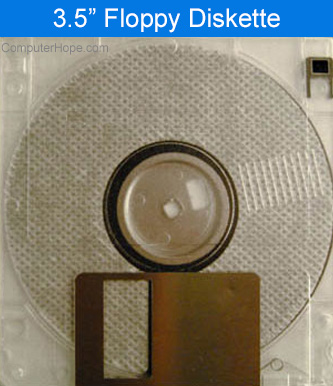3.5-inch diskette

A 3.5-inch diskette was first created by IBM in 1984 with an initial capacity of 720 KB and later 1.44 MB that replaces 5.25" diskettes. These disks were the most commonly used methods to backup and store data in the 1990s, but became obsolete the introduction of CD-R (Compact Disc Recordable) discs and USB (Universal Serial Bus) thumb drives.
The 3.5-inch floppy diskette has dimensions of 8.9cm in width by 9.3cm in height. It's called a floppy because of the circular magnetic floppy in the hard shell. 3.5-inch floppy diskettes come in sizes of 720 KB low-density, 1.44 MB high density capacity, and IBM even developed an extended density disk capable of holding 2.88 MB. The picture is a clear picture of a 3.5" floppy diskette, with a circular cloth on both sides of the floppy. The cloth helps clean and protect the magnetic disk in the diskette.
Floppy write protect tab
In the diagram above, notice the small write protect tab. This tab enables the floppy disk to be switched from write-protected and unwrite-protected. Move the tab to the top position, creating a hole, makes the disk write protected. Moving the tab to the bottom position disables write protection, allowing the diskette can be written too or have information deleted from it. Some cheaper disks may be missing this tab. To write information to the diskette, you have to place a piece of scotch tape over the hole.
High Density hole
Second, the top-right corner of the back of the floppy has a small hole. If the drive mechanism detects that this hole exists, the computer knows it is a high-density diskette.
Middle of a floppy diskette
Third, the circular metal disk in the middle of the floppy diskette. This part rotates the magnetic medium in the floppy disk casing.
Read/write access door
Finally, there is a metal door that can be moved left and then will snap back to its original position. This door is allows the read/write head in the floppy drive to access the magnetic medium in the casing. Once the diskette is removed, this door will snap back into position, helping to prevent anything from getting on the magnetic medium and destroying it. The door also increases the longevity of the magnetic disk.
Using floppy disks today
Today, the 3.5-inch diskette and drive has been replaced by CD-R discs and USB thumb drives. For those who want to still read older floppy diskettes on their newer computers, external USB floppy drives can be purchased.
5.25-inch diskette, Diskette, Drive, Floppy, Floppy drive terms, Magnetic, Media, Storage
